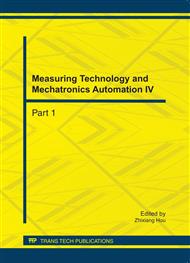[1]
Y.L. Shi, L.L. Wang, S.B. Liu, and H.G. Nie, Development of chemical fertilizer industry and its effect on agriculture of China. Acta Pedologica Sinica, 45(5): 852-864 (2008).
Google Scholar
[2]
X. Yan, J.Y. Jin, P. He, and M.Z. Liang, Recent advances in technology of increasing fertilizer use efficiency. Scientia Agricultura Sinica, 41(2): 450-459 (2008).
Google Scholar
[3]
R. Khosla, D. Westfall, R. Reich, and D. Inman, Temporal and spatial stability of soil test parameters used in precision agriculture. Comm. Soil. Sci. Plant Anal. 37: 2127-2136 (2006).
DOI: 10.1080/00103620600817127
Google Scholar
[4]
X.M. Tang, G.X. Zhao, and Q.B. Lu, Research of soil testing and fertilizer recommendations at county level by GIS. Transactions of the CSAE, 24(7): 34-38 (2008).
Google Scholar
[5]
J. Triantafilis, A.I. Huckel, and I.O.A. Odeh, Comparison of statistical prediction methods for estimating field-scale clay content using different combinations of ancillary variables. Soil. Sci. 166: 415-427 (2000).
DOI: 10.1097/00010694-200106000-00007
Google Scholar
[6]
B.C. Atherton, M.T. Morgan, S.A. Shearer, T.S. Stombaugh, and A.D. Ward, Site-specific farming: A perspective on information needs, benefits and limitations. Journal of Soil and Water Conservation, 54: 455-461 (1999).
Google Scholar
[7]
E. Ben-Dor and A. Banin, Near infrared analysis as a rapid method to simultaneously evaluate several soil properties. Soil Science Society of America Journal, 59: 364–372 (1995).
DOI: 10.2136/sssaj1995.03615995005900020014x
Google Scholar
[8]
D. Cozzolino, and A. Moron, The potential of near infrared reflectance spectroscopy to analyse soil chemical and physical characteristics. J. Agri. Sci. Cambridge 140, 65–71 (2003).
DOI: 10.1017/s0021859602002836
Google Scholar
[9]
Y. Z Wu, J. Chen, X.M. Wu, Q.J. Tian, J.F. Ji, and Z.H. Qin, Possibilities of reflectance spectroscopy for the assessment of contaminant elements in suburban soils, Applied Geochemistry 20: 1051–1059 (2005).
DOI: 10.1016/j.apgeochem.2005.01.009
Google Scholar
[10]
W. Li, S.H. Zhang, Q. Zhang, C.W. Dong, and S.Q. Zhang, Rapid prediction of available N, P and K con ten t in soil using near- infrared reflectance spectroscopy, Transact ions of the CSA E, 23: 55-59 (2007).
Google Scholar
[11]
X.L. Zhang, X.N. Li, J.Y. Wu, W. Zheng, Q. Huang, and C. F, Tang, Study on the Determination of Total Nitrogen(TN) in Different Types of Soil by Near-Infrared Spectroscopy (NIS), Spectroscopy and Spectral Analysis, 30(4): 906-910 (2010).
Google Scholar
[12]
A.L. Page, R.H. Miller, and D.R. Keeney, Methods of Soil Analysis. American Society of Agronomy/ Soil Science Society of America, Madison. (1996).
Google Scholar
[13]
C. Gianello and J.M. Bremner A simple method of assessing potentially available organic nitrogen in soils. Communications in Soil and Plant Analysis, 17: 195-214 (1986).
DOI: 10.1080/00103628609367708
Google Scholar
[14]
R.J. Barnes, M.S. Dhanoa, and S.J. Lister, Standard normal variate transformation and detrending of Near-Infrared Diffuse Reflectance Spectra. Appl. Spectrosc. 43(5): 772-777 (1989).
DOI: 10.1366/0003702894202201
Google Scholar
[15]
G.R. Philips and E.M. Eyring. Comparison of conventional and robust regression in analysis of chemical data. Analytical Chemistry, 55: 1134-1138 (1983).
DOI: 10.1021/ac00258a035
Google Scholar
[16]
M. Otto, translated by X.G. Shao, W.S. Cai, X.J. Xu, Chemometrics: Statistics and Computer Application in Analytical Chemistry. Beijing: Scientific Publishing Company. (2003).
Google Scholar
[17]
R.J. Beckman and R.D. Cook, Outliers (with comments). Technometrics. 25: 119—163 (1983).
Google Scholar
[18]
P. Williams, K. Norris, Near-infrared technology in the agricultural and food industries. American Association of Cereal Chemists, Saint Paul, MN. (2001).
Google Scholar
[19]
G.R. Hunt, Spectroscopic properties of rocks and minerals. In R.S. Carmichael (ed. ) Handbook of physical properties of rocks. CRC Press, Boca Raton, FL. p.295–385. (1982).
Google Scholar
[20]
K.D. Shepherd and M.G. Walsh Development of reflectance spectral libraries for characterization of soil properties. Soil science society of America journal, 66: 988-998 (2002).
DOI: 10.2136/sssaj2002.9880
Google Scholar


